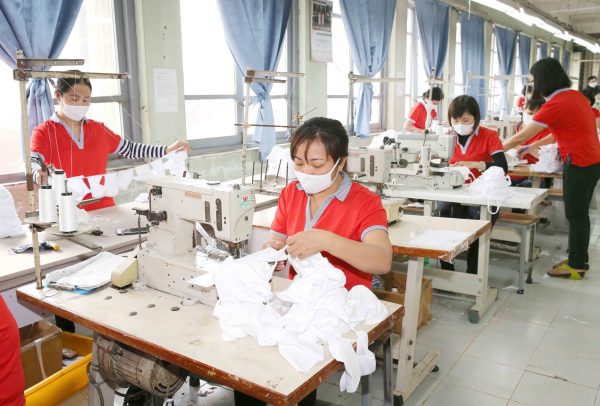Although PPE production has ramped up in many countries around the world, there is still significant excess demand, particularly in vulnerable countries. UNICEF estimates that low- and middle-income countries will need 2.2 billion surgical masks, 1.1 billion gloves, 13 million goggles and 8.8 million face shields by the end of 2020.
Managing the current supply chain to meet surging demand is challenging. Many producers have already exceeded their surge capacity. Major disruptions to global supply chains and logistics due to stringent containment measures are also hobbling output.
Germany and the United States are the largest producers of face masks for their regions. But the world’s largest producer of face masks, China, plays a central role in producing and exporting masks to both Asia and the world. Although mask production in China has significantly increased as its lockdown eases, the increased production has created quality issues, which has renewed disruptions in global distribution. Some sub-standard products led to stringent customs inspections and were recalled from the market.
Similar patterns are observed for protective gowns and goggles. China, Malaysia and Thailand are the top three exporters of gloves. Manufacturers of other types of personal protective equipment that rely on raw materials or products from China have also been affected. Supplies are depleting as distribution grinds to a halt. Transport and workforce constraints caused by roadblocks, quarantines and pandemic containment measures are affecting supply chains throughout the region and the world.
Even if factories could gear up to meet the demand, they still might not be able to get supplies to the people who need them. The World Trade Organization (WHO) reports that 80 countries have instituted export bans, including major producers of PPE, since the outbreak of the pandemic.
Efforts within and across borders should be made to boost production and open up exports. Countries should also mobilise available supplies more efficiently, map manufacturing facilities and closely monitor supply and demand.
Many countries have tried innovative ways to increase production by offering incentives to manufacturers. They are converting production lines from other manufacturing sectors — like textile companies — to produce masks, gloves and gowns. They are also relaxing regulatory restrictions. Guidance is being provided on the use of PPE to avoid wastage.
Beyond national efforts, concerted efforts are needed globally on multiple fronts to efficiently use PPE, boost its availability and strengthen PPE readiness. There is a lot that can be done to achieve this.
First, better quality information about the availability of products in the market, production capacity and supply response is critical. It is important to improve transparency along global supply chains, identify a list of critical components and their sources and mobilise alternative sources and options.
A key challenge is the absence of a system-wide mechanism to track the amount of PPE circulating in markets and in use. Another challenge is to centrally monitor the evolution of supply and demand. An efficient, low-burden mechanism for governments and private sector partners to share situational and supply information should be developed. In the aftermath of COVID-19, the supply chain management of PPE should transform to ensure that all countries hold adequate inventories.
Second, countries should work together to improve resource allocation and production capacity. Given high cross-border interdependence, all nations will benefit from leaving doors open for trade in critical components and medical supplies, which includes streamlining customs procedures and cross-border freight logistics for these items. International cooperation is essential to provide secure supply chains and logistics, estimate availability and capacity and accelerate transportation.
Third, surge capacity and trade logistics support need to be prioritised. This includes addressing the cash flow constraints and trade restrictions facing manufacturers, which are often small- and medium-sized enterprises. Financial assistance can be mobilised to help them manage capital shortages, hire workers and obtain the machines needed for production and distribution.
Finally, regional economies and institutions need to strengthen collaboration with established global mechanisms like the Pandemic Supply Chain Network coordinated by the WHO. As countries and regions face different infection curves at different times, efficient resource allocation on a global scale will help support individual countries by minimising strains on limited domestic resources.
Cyn-Young Park is Director of Regional Cooperation and Integration in the Asian Development Bank’s Economic Research and Regional Cooperation Department.
Kijin Kim is an economist in the Asian Development Bank’s Economic Research and Regional Cooperation Department.
This article is part of an EAF special feature series on the novel coronavirus crisis and its impact.
A version of this article originally appears here in the Asian Development Bank’s Briefs.


Every country should have its own industries of producing medical supplies and drugs so they are not vulnerable in relying on a few countries to supply their needs. The American Democrats are looking into restoring the American medical and drug manufacturing industries in the USA so the country will not be relying on Chinese and Indian medical manufacturing industries. Years ago, it was the USA who would be sending medical supplies to medical crises; however, thanks to outsource its manufacturing industries, the USA has to import the medical supplies. What a sad state of affairs in the richest country in the world.